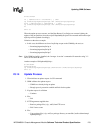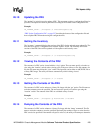
MPCMM0001 Chassis Management Module Software Technical Product Specification 219
IPMI Pass-Through
The request string will only be validated for the format and ranges specified above. Any further
validation of the command or data is left up to the receiver. If the range or format validation fails
the error code of E_CLI_INVALID_SET_DATA will be returned.
Note: Please refer to the IPMI Specification for further details on IPMI commands and the values
described above.
25.2.2 Response String
On a successful transmission, this is a space delimited string containing the data returned as the
response to the IPMI request. All the values will be decimal integers. There will always be at least
one number returned and is the completion code of the command. The number and meaning of rest
of the numbers is dependent on the command sent.
Upon a failure in transmission an error code will be returned from the CLI API. It’s left up to the
caller to interpret this code.
25.2.3 Usage Examples
25.2.3.1 CLI Usage Example
Sending an AdvancedTCA* Get PICMG Properties command to LUN 0 of blade 7:
# cmmset -l blade7 -d IPMICommand -v "0x2c L0 1 0"
0 0 71 142 255 0 4 0
25.2.3.2 RCP Usage Example
Sending an AdvancedTCA* Get PICMG Properties command to LUN 0 of blade 7:
# cli_client –s MPCMM0001 –m set -l blade7 –d IPMICommand -v “0x2c 1 L0 0”
0 0 71 142 255 0 4 0
25.3 SNMP
Because SNMP sets cannot return data the IPMI pass-through functionality will be split into two
SNMP objects under each location: IPMICommandReq and IPMICommandRes (OIDs TBD).
IPMICommandReq will be Read-Write. On a read (get) it will return a string (initially empty)
containing the last successful request performed via SNMP. On a write (set) it will return whether
the IPMI command was successfully sent and the response was successfully received.
IPMICommandRes will be Read-Only and will return the response string of the last successful
IPMICommand. In order to differentiate between requests, the response string will also be
followed by the request string separated by “#”.
25.3.1 Usage Example
Sending IPMI Get Device ID request to the CMM:


















